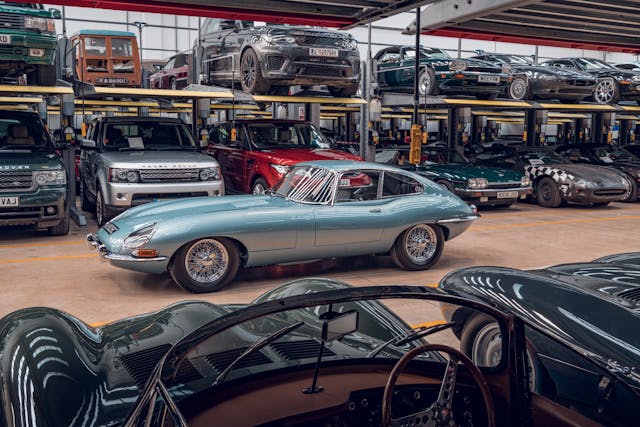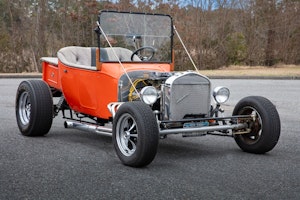Media | Articles
Jaguar’s “Reborn” E-Type is a 1960s dream come to life
As soon as Jaguar had pulled the covers off the new E-Type at the Geneva Motor Show of 1961, it walked into a problem. You couldn’t get your hands on one for love nor money.
The E-Type’s curvesome form, promise of 150 mph on the nation’s newfangled motorway network, and a startlingly low price of just £2098 (or $5620) sparked an avalanche of orders. Jaguar had launched models that garnered immediate popularity in the past—most notably the XK120 13 years earlier—but it was nothing compared to E-Type’s reception.
Within a very short space of time the tiny Coventry factory had hundreds of thousands of pounds’ worth of orders, but not the production capacity to match. The queue for delivery steadily got longer and, the story goes, eager buyers would place orders at several different dealers in order to jump the waiting list.
Unless your name was Adam Faith—the pop star who phoned Sir William Lyons and begged him to allocate him one of the six right-hand-drive cars within weeks of the car’s Geneva reveal—or any other celebrity in the ’60s, it was a queue you had to join and wait.

For the first six months, at least, Jaguar was satisfying American demand, meaning the closest British buyers got to an E-Type was a brochure from their local dealer. Even when cars filtered through to owners in the U.K., choice at the time of ordering had been limited, the company needing to keep things simple to keep up with demand.
Marketplace
Buy and sell classics with confidence
Throughout most of the ’60s, the E-Type’s appeal grew stronger and even a little white lie did little to diminish the want-factor. While Jaguar claimed the E could reach the magical 150 mph, it was later revealed the press department’s cars had their 3.8-liter straight-six engines gently massaged—the customer cars, though still potent, couldn’t top 150 mph. So, in 1965, the 3.8 was cast aside and replaced by an engine the E arguably should have had from the very start. With an extra 400 cc, the 4.2 was more truthful to the brochure’s 150-mph claims, and the fact that it was a little easier and more comfortable to drive sealed the deal.
In 1968 came the buxom Series 2, followed three years later by the full-fat and Americanized Series 3 V-12. The last of the breed rolled off the Browns Lane factory production line in ’75 and almost immediately values of the early 3.8s started to creep upwards. By the late 1980s, demand for the E boomed once again and owners could practically ask what they liked in the classic car market. Values crashed in the ’90s before shooting up again in 2011 when the car celebrated its half-century.

Although it’s been 60 years since Jaguar revealed the E-Type, the British brand knows its most famous car is still a money-maker and it hasn’t been slow to capitalize on customer demand. First, Jaguar Land Rover Special Operations announced plans in August 2014 to build six E-Type Lightweights—each car coming with one of the remaining chassis numbers originally allocated in 1963 to the intended 18-car Lightweight project (of which just 12 were built). Very much designed as “continuation” cars and not factory copies, all six were eventually built at £1.5M each (or $2.37M today). They sold out almost immediately and still command a premium at auction.
Then, in 2019, recognizing the prices original E-Type tool kits fetched at auction, Jaguar Classic allowed customers to buy brand-new kits with meticulously copied tools wrapped up in a leatherette roll and charged an alarming £732 ($941). Last summer, Jaguar Classic “reintroduced” 3.8-liter engine blocks.
The most interesting part of Jaguar’s obsession with the E-Type, however, is the Reborn program. It’s important to point out here an E-Type Reborn is not a continuation model like the recent run of Aston Martin DB4 GT cars, and nor is it a creative Singer-esque restomod—a past car reimagined for today’s drivers. Jaguar is all too well aware of the popularity and the market for perfectly restored, concours-standard E-Types, but with the Reborn program it’s going one better.

For those who don’t want to spend anything from £150,000 ($207,000) upwards on a fully restored E from a leading specialist and effectively want a brand new E-Type specified exactly as they’d like it, and built by the same company behind the original, Jaguar will welcome them to their multi-million-pound Classic Works in Ryton-on-Dunsmore.
In a corner of the main showroom and behind a large barn-style door lies the E-Type Reborn commissioning room. In the middle of the space sits an example of Classic’s restoration handiwork—an immaculately presented Series 1 2+2—in the corner are two leather chairs and a table and around the room lie paint samples of every color the E-type ever came in.
It’s here where the Reborn customer chooses every little detail of their new E-Type. And unlike in the 1960s, you can choose a car Jaguar Classic already has in stock or give the green light for one of Classic’s buyers to source a suitable donor car from anywhere in the world. Modern upgrades can be specified including electronic ignition, improved cooling and a synchromesh gearbox, while for £1200 ($1658) Classic Works will even fit an infotainment system with sat nav, USB input, DAB, and Bluetooth that’s cleverly designed to look like an original 1960s factory-fitted radio.
With prices starting at £295,000 ($407,600) and rising to £325,000 ($449,000) depending on specification, an E-Type Reborn isn’t the type of car lottery winners buy on a whim—and describing the archetypal customer is next to impossible.
“There is no typical buyer,” says David Moore, project engineer for Classic Works. “Whilst we do get very rich customers who sometimes send a representative, many Reborn customers are people who have always wanted an E-Type and having one rebuilt by Jaguar in Coventry is the perfect dream.”
Moore explains customers are invited to see the progress of the build which is all done behind a large glass wall between the showroom and the workshops. The total Classic Works facility occupies some 14,000 square meters and a large chunk of that is devoted to the workshops. Running along one side are servicing bays for XJ220s; in the far left-hand corner lies the leather room, with every type of hide suitable for a Jaguar interior; and out the back, affectionately known as “The Toyshop,” lies the classic car collection, with virtually every model Jaguar and Land Rover has ever made, along with other important British classics.

But back in the main workshop and running down the center lies the E-Type Reborn operation. Some 30 bays are dedicated to Reborn builds; every car, whether sourced from the customer or by Classic itself is stripped painstakingly back to bare metal, the engine removed and the car lovingly taken apart—but, importantly, as many original parts are kept as possible. If the car needs any replacement body parts, perhaps due to corrosion—a classic E-Type foible—panels are sourced through Classic’s reverse-engineered panel program to ensure perfect fit, and are spot-welded in the same fashion as they were in the ’60s. Then comes several thick coats of paint and the process of building up the car back to factory specification, integrating any modifications and customizations requested by the customer.
Authenticity is guaranteed as Jaguar Classic has unique access to build records and original drawings from the Jaguar Heritage Trust, so every piece, unless the customer requests something different, is near-identical to how it would have looked in period. Safety-critical items are replaced with new items from Jaguar Parts and, if the customer has selected any upgrades, those are fitted as well. As each car is different, Classic doesn’t quote an average build time, but we’re told thousands of hours go into each Reborn and a typical build, from commission to handover, takes six months.

Jaguar Classic’s Reborn demonstrator is a ’65 Series 1 4.2 finished in Opalescent Silver Blue. Twist the key, thumb the starter, give the straight-six a generous prod on the throttle and the Reborn reacts urgently. The black leather seats may be unblemished and the wooden wheel’s sheen flawless, but the Reborn doesn’t smell like a new car. Nor does it feel like a car that’s had a thorough going-over. The four-speed ‘box still needs a smart shove into third, the brakes want warming up, and the steering requires some respect; it’s razor-sharp.
I’ve driven quite a few E-Types and the Reborn, funnily enough, feels the freshest of them all. After a few miles on some deserted Warwickshire roads, it’s clear the Reborn doesn’t just feel incredibly well-sorted; it’s also the nearest I’ll ever get to the sheer excitement the original owner would have felt in 1965. Perhaps it’s purely psychological, but there’s an eagerness to the car that I’ve certainly never felt in a pristinely restored E.
Putting aside the emotions, it’s evident the E-Type still has the excitement factor even 60 years on. Tip the E into a corner and the body rolls and flexes gently. Every slight input you put into the steering is translated to the front wheels, and then, as the corner opens up, you lean on the throttle, the bonnet rises and the engine reacts—muffled at first, and then a sharp howl past 2500 rpm. The E is still as intoxicating as it was the ’60s.

It’s easy to see why some buyers opt for a Reborn instead of a restored car. Because no matter how perfect a restoration is, there’s a romance to a Reborn in that it’s been hand-built by Jaguar engineers in a workshop less than 10 miles away from where Es were originally made at Jaguar’s Browns Lane factory. Expensive it may be, but for those who fall for the romantic ideal of ordering an E-Type from the factory, it’s a price worth paying.

























